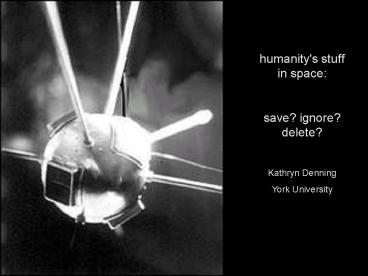humanity's stuff in space: - PowerPoint PPT Presentation
Title:
humanity's stuff in space:
Description:
humanity's stuff in space: save? ignore? delete? Kathryn Denning York University – PowerPoint PPT presentation
Number of Views:85
Avg rating:3.0/5.0
Title: humanity's stuff in space:
1
humanity's stuff in space save? ignore? delete?
Kathryn Denning York University
2
Monthly Number of Catalogued Objects in Earth
Orbit by Object Type. n.b. Fragmentation
satellite breakup and anomalous event debris, as
opposed to mission-related debris, which is
intentional. Source Orbital Debris Quarterly
News, vol 10 issue 2, April 2006. NASA.
Catalogued by U.S. Space Surveillance Network.
3
Objects in Low Earth Orbit approximately 95
of objects are orbital debris rather than
functional satellites. (dots not to
scale!) Source NASA
4
Objects in Geosynchronous Orbit 35 785 km
altitude Again, mostly orbital debris Source
NASA
5
Objects in Geosynchronous Orbit Polar view
Source NASA
6
(No Transcript)
7
(No Transcript)
8
(No Transcript)
9
(No Transcript)
10
Rt panel from Long Duration Exposure Facility,
after being in LEO in 5.7 years, until Jan 1990
11
(No Transcript)
12
(No Transcript)
13
(No Transcript)
14
(No Transcript)
15
(No Transcript)
16
Effective number of LEO objects, 10 cm and
larger, from simulation by J.-C. Liou and N.L.
Johnson. Best-case scenario based on assumption
of no new launches after 1 Jan 2005. Source
Orbital Debris Quarterly News, vol 10 issue 2,
April 2006. NASA, and Science 20 Jan 2006.
17
(No Transcript)
18
(No Transcript)
19
STILL OUT THERE. From top left, by row Ranger
4, impact 1962 Ranger 7, impact 1964, first US
moon images Luna 9, USSR, 1966 Surveyor, US,
1966 Luna 13, USSR, 1966 Luna 16, USSR, 1970 Luna
17/Lunakhod 1, USSR lander first rover,
1970 Lunakhod 2 rover, 1973, lander Luna 1,
USSR flyby in 1959, now in heliocentric orbit
20
(No Transcript)
21
Probable artifact locations at Tranquility
Base. Lunar Legacy Project.
22
Plaque left on the moon surface as part of the
Apollo 11 mission. (It would be so nice if all
archaeological sites were helpfully labelled for
posterity like this.)
23
Venera 9, 1975, the first to take pictures of
Venus surface
24
(No Transcript)
25
(No Transcript)
26
(No Transcript)
27
(No Transcript)
28
Space Heritage Task Force of the World
Archaeological Congress 2004 onwards Some of our
objectives Identify examples of places,
sites, and objects that have exceptional cultural
value and whose preservation will benefit all
humankind Propose a set of cultural,
historical, social and scientific criteria for
preserving space heritage places of exceptional
cultural heritage value Investigate avenues
for preservation within existing legal
frameworks, e.g. World Heritage Convention
Figure out which institutions might support
programs of preservation / protection
29
2004 - Space Shuttle Columbia Crew memorial on
Mars, at the site of the Mars Spirit rover
landing.
30
Humanitys story from Laetoli to other worlds
31
Questions for you as scholars, citizens of
nation(s) and the world, and human beings
What categories of objects or sites do you
think should be preserved? (If any.) Why? In
general, what should the criteria (cultural,
historical, scientific) be for identifying
exceptionally important objects or sites?































